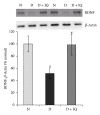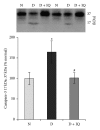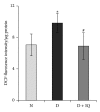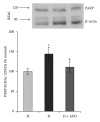Poly (ADP-ribose) polymerase mediates diabetes-induced retinal neuropathy
- PMID: 24347828
- PMCID: PMC3857786
- DOI: 10.1155/2013/510451
Poly (ADP-ribose) polymerase mediates diabetes-induced retinal neuropathy
Abstract
Retinal neuropathy is an early event in the development of diabetic retinopathy. One of the potential enzymes that are activated by oxidative stress in the diabetic retina is poly (ADP-ribose) polymerase (PARP). We investigated the effect of the PARP inhibitor 1,5-isoquinolinediol on the expression of the neurodegeneration mediators and markers in the retinas of diabetic rats. After two weeks of streptozotocin-induced diabetes, rats were treated with 1,5-isoquinolinediol (3 mg/kg/day). After 4 weeks of diabetes, the retinas were harvested and the levels of reactive oxygen species (ROS) were determined fluorometrically and the expressions of PARP, phosporylated-ERK1/2, BDNF, synaptophysin, glutamine synthetase (GS), and caspase-3 were determined by Western blot analysis. Retinal levels of ROS, PARP-1/2, phosphorylated ERK1/2, and cleaved caspase-3 were significantly increased, whereas the expressions of BDNF synaptophysin and GS were significantly decreased in the retinas of diabetic rats, compared to nondiabetic rats. Administration of 1,5-isoquinolinediol did not affect the metabolic status of the diabetic rats, but it significantly attenuated diabetes-induced upregulation of PARP, ROS, ERK1/2 phosphorylation, and cleaved caspase-3 and downregulation of BDNF, synaptophysin, and GS. These findings suggest a beneficial effect of the PARP inhibitor in increasing neurotrophic support and ameliorating early retinal neuropathy induced by diabetes.
Figures








Similar articles
-
The Poly(ADP-Ribose)Polymerase-1 Inhibitor 1,5-Isoquinolinediol Attenuate Diabetes-Induced NADPH Oxidase-Derived Oxidative Stress in Retina.J Ocul Pharmacol Ther. 2018 Sep;34(7):512-520. doi: 10.1089/jop.2017.0117. Epub 2018 Jun 18. J Ocul Pharmacol Ther. 2018. PMID: 29912609
-
Mutual enhancement between high-mobility group box-1 and NADPH oxidase-derived reactive oxygen species mediates diabetes-induced upregulation of retinal apoptotic markers.J Physiol Biochem. 2015 Sep;71(3):359-72. doi: 10.1007/s13105-015-0416-x. Epub 2015 Jun 4. J Physiol Biochem. 2015. PMID: 26040511
-
Poly(ADP-ribose) polymerase inhibition alleviates experimental diabetic sensory neuropathy.Diabetes. 2006 Jun;55(6):1686-94. doi: 10.2337/db06-0067. Diabetes. 2006. PMID: 16731831 Free PMC article.
-
Role for poly(ADP-ribose) polymerase activation in diabetic nephropathy, neuropathy and retinopathy.Curr Vasc Pharmacol. 2005 Jul;3(3):267-83. doi: 10.2174/1570161054368634. Curr Vasc Pharmacol. 2005. PMID: 16026323 Review.
-
Poly(ADP-ribose) Polymerase-1: An Update on Its Role in Diabetic Retinopathy.Discov Med. 2021 Jul-Aug;32(165):13-22. Discov Med. 2021. PMID: 35219352 Review.
Cited by
-
Poly (ADP-Ribose) Polymerase-1 (PARP-1) Inhibitors in Diabetic Retinopathy: An Attractive but Elusive Choice for Drug Development.Pharmaceutics. 2024 Oct 11;16(10):1320. doi: 10.3390/pharmaceutics16101320. Pharmaceutics. 2024. PMID: 39458649 Free PMC article. Review.
-
Propolis ethanol extract abrogates hyperglycemia, lipotoxicity, and lowered hepatic poly (ADP-ribose) polymerase protein level in male albino rats.J Diabetes Metab Disord. 2021 Apr 27;20(1):683-696. doi: 10.1007/s40200-021-00800-8. eCollection 2021 Jun. J Diabetes Metab Disord. 2021. PMID: 34178859 Free PMC article.
-
A Promising Combination: PACAP and PARP Inhibitor Have Therapeutic Potential in Models of Diabetic and Hypertensive Retinopathies.Cells. 2021 Dec 9;10(12):3470. doi: 10.3390/cells10123470. Cells. 2021. PMID: 34943979 Free PMC article.
-
Neuroprotection as a Therapeutic Target for Diabetic Retinopathy.J Diabetes Res. 2016;2016:9508541. doi: 10.1155/2016/9508541. Epub 2016 Mar 31. J Diabetes Res. 2016. PMID: 27123463 Free PMC article. Review.
-
JNK Activation Contributes to Oxidative Stress-Induced Parthanatos in Glioma Cells via Increase of Intracellular ROS Production.Mol Neurobiol. 2017 Jul;54(5):3492-3505. doi: 10.1007/s12035-016-9926-y. Epub 2016 May 16. Mol Neurobiol. 2017. PMID: 27181592
References
-
- Seki M, Tanaka T, Nawa H, et al. Involvement of brain-derived neurotrophic factor in early retinal neuropathy of streptozotocin-induced diabetes in rats: therapeutic potential of brain-derived neurotrophic factor for dopaminergic amacrine cells. Diabetes. 2004;53(9):2412–2419. - PubMed
-
- Barber AJ. A new view of diabetic retinopathy: a neurodegenerative disease of the eye. Progress in Neuro-Psychopharmacology and Biological Psychiatry. 2003;27(2):283–290. - PubMed
-
- Simó R, Hernández C, European consortium for the early treatment of diabetic retinopathy (EUROCONDOR) Neurodegeneration is an early event in diabetic retinopathy: therapeutic implications. British Journal of Ophthalmology. 2012;96(10):1285–1290. - PubMed
MeSH terms
Substances
LinkOut - more resources
Full Text Sources
Other Literature Sources
Medical
Research Materials
Miscellaneous

